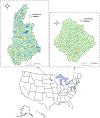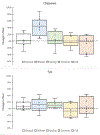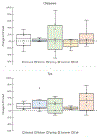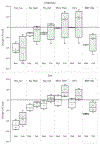Modeling the Effects of Future Hydroclimatic Conditions on Microbial Water Quality and Management Practices in Two Agricultural Watersheds
- PMID: 34327039
- PMCID: PMC8318128
- DOI: 10.13031/trans.13630
Modeling the Effects of Future Hydroclimatic Conditions on Microbial Water Quality and Management Practices in Two Agricultural Watersheds
Abstract
Anticipated future hydroclimatic changes are expected to alter the transport and survival of fecally-sourced waterborne pathogens, presenting an increased risk of recreational water quality impairments. Managing future risk requires an understanding of interactions between fecal sources, hydroclimatic conditions and best management practices (BMPs) at spatial scales relevant to decision makers. In this study we used the Hydrologic Simulation Program FORTRAN to quantify potential fecal coliform (FC - an indicator of the potential presence of pathogens) responses to a range of mid-century climate scenarios and assess different BMP scenarios (based on reduction factors) for reducing the risk of water quality impairment in two, small agricultural watersheds - the Chippewa watershed in Minnesota, and the Tye watershed in Virginia. In each watershed, simulations show a wide range of FC responses, driven largely by variability in projected future precipitation. Wetter future conditions, which drive more transport from non-point sources (e.g. manure application, livestock grazing), show increases in FC loads. Loads typically decrease under drier futures; however, higher mean FC concentrations and more recreational water quality criteria exceedances occur, likely caused by reduced flow during low-flow periods. Median changes across the ensemble generally show increases in FC load. BMPs that focus on key fecal sources (e.g., runoff from pasture, livestock defecation in streams) within a watershed can mitigate the effects of hydroclimatic change on FC loads. However, more extensive BMP implementation or improved BMP efficiency (i.e., higher FC reductions) may be needed to fully offset increases in FC load and meet water quality goals, such as total maximum daily loads and recreational water quality standards. Strategies for managing climate risk should be flexible and to the extent possible include resilient BMPs that function as designed under a range of future conditions.
Keywords: Climate; Management responses; Microbial water quality; Modeling; Watersheds.
Figures










Similar articles
-
AGRICULTURAL BEST MANAGEMENT PRACTICE SENSITIVITY TO CHANGING AIR TEMPERATURE AND PRECIPITATION.Trans ASABE. 2019 Jan 2;62(4):1021-1033. doi: 10.13031/trans.13292. Trans ASABE. 2019. PMID: 34671506 Free PMC article.
-
Fecal coliform modeling under two flow scenarios in St. Louis Bay of Mississippi.J Environ Sci Health A Tox Hazard Subst Environ Eng. 2010;45(3):282-91. doi: 10.1080/10934520903467949. J Environ Sci Health A Tox Hazard Subst Environ Eng. 2010. PMID: 20390869
-
Assessing Dungeness River Functionality and Effectiveness of Best Management Practices (BMPs) Using an Ecological Functional Approach.Am J Environ Engineer. 2019 Oct 1;9(2):36-54. Am J Environ Engineer. 2019. PMID: 32704436 Free PMC article.
-
Evaluating best management practices for nutrient load reductions in tile-drained watersheds of the Laurentian Great Lakes Basin: A literature review.Sci Total Environ. 2025 Feb 15;965:178657. doi: 10.1016/j.scitotenv.2025.178657. Epub 2025 Jan 31. Sci Total Environ. 2025. PMID: 39892229 Review.
-
Humic substances-part 7: the biogeochemistry of dissolved organic carbon and its interactions with climate change.Environ Sci Pollut Res Int. 2009 Sep;16(6):714-26. doi: 10.1007/s11356-009-0176-7. Epub 2009 May 22. Environ Sci Pollut Res Int. 2009. PMID: 19462191 Review.
Cited by
-
A review of climate change effects on practices for mitigating water quality impacts.J Water Clim Chang. 2022 Mar 22;13:1684-1705. doi: 10.2166/wcc.2022.363. J Water Clim Chang. 2022. PMID: 36590233 Free PMC article.
References
-
- Abatzoglou JT, & Brown TJ (2012). A comparison of statistical downscaling methods suited for wildfire applications. International Journal of Climatology, 32(5), 772–780. doi:10.1002/joc.2312 - DOI
-
- Agouridis CT, Workman SR, Warner RC, & Jennings GD (2005). LIVESTOCK GRAZING MANAGEMENT IMPACTS ON STREAM WATER QUALITY: A REVIEW1. JAWRA Journal of the American Water Resources Association, 41(3), 591–606. doi:10.1111/j.1752-1688.2005.tb03757.x - DOI
-
- Baffaut C. (2010). Bacteria Modeling with SWAT for Assessment and Remediation Studies: A Review. Transactions of the ASABE, v. 53(no. 5), pp. 1585–1594-2010 v.1553 no.1585. Retrieved from http://asae.frymulti.com/toc_journals.asp?volume=53&issue=5&conf=t&orgco...
-
- Benham BL, Baffaut C, Zeckoski RW, Mankin KR, Pachepsky YA, Sadeghi AM, … Habersack MJ (2006). MODELING BACTERIA FATE AND TRANSPORT IN WATERSHEDS TO SUPPORT TMDLS. Transactions of the ASABE, 49(4), 987–1002. doi:10.13031/2013.21739 - DOI
Grants and funding
LinkOut - more resources
Full Text Sources
